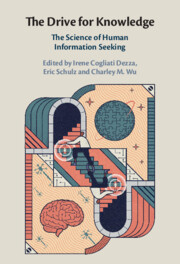Book contents
- The Drive for Knowledge
- The Drive for Knowledge
- Copyright page
- Contents
- Figures
- Tables
- Notes on Contributors
- Preface
- Part I What Drives Humans to Seek Information?
- Chapter 1 The Motivational Processes of Sense-Making
- Chapter 2 From Curiosity to Interest
- Chapter 3 Curiosity-Driven Exploration
- Chapter 4 Searching for Information, from Infancy to Adolescence
- Part II How Do Humans Search for Information?
- Part III Which Machinery Supports the Drive for Knowledge?
- Index
- References
Chapter 3 - Curiosity-Driven Exploration
Diversity of Mechanisms and Functions
from Part I - What Drives Humans to Seek Information?
Published online by Cambridge University Press: 19 May 2022
- The Drive for Knowledge
- The Drive for Knowledge
- Copyright page
- Contents
- Figures
- Tables
- Notes on Contributors
- Preface
- Part I What Drives Humans to Seek Information?
- Chapter 1 The Motivational Processes of Sense-Making
- Chapter 2 From Curiosity to Interest
- Chapter 3 Curiosity-Driven Exploration
- Chapter 4 Searching for Information, from Infancy to Adolescence
- Part II How Do Humans Search for Information?
- Part III Which Machinery Supports the Drive for Knowledge?
- Index
- References
Summary
Intrinsically motivated information-seeking, also called curiosity-driven exploration, is widely believed to be a key ingredient for autonomous learning in the real world. Such forms of spontaneous exploration have been studied in multiple independent lines of computational research, producing a diverse range of algorithmic models that capture different aspects of these processes. These algorithms resolve some of the limitations of neurocognitive theories by formally describing computational functions and algorithmic implementations of intrinsically motivated learning. Moreover, they reveal a high diversity of effective forms of intrinsically motivated information-seeking that can be characterized along different mechanistic and functional dimensions. This chapter aims at reviewing different classes of algorithms and highlighting several important dimensions of variation among them. Identifying these dimensions provides means for structuring a comprehensive taxonomy of approaches. We believe this exercise to be useful in working toward a general computational account of information-seeking. Such an account should facilitate the proposition of new hypotheses about information-seeking in humans and complement the existing psychological theory of curiosity.
- Type
- Chapter
- Information
- The Drive for KnowledgeThe Science of Human Information Seeking, pp. 53 - 76Publisher: Cambridge University PressPrint publication year: 2022
References
- 1
- Cited by

